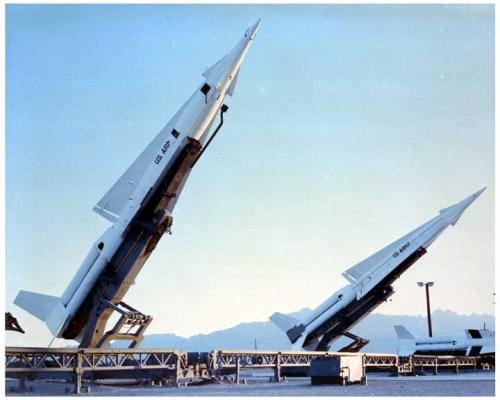Western Electric MIM-14 Nike Hercules (original) (raw)
The Nike Hercules was the only nuclear-armed surface-to-air weapon, which was operational with the U.S. Army. Development of an improved Nike missile began in 1952, with the primary goal to develop a missile with a significantly higher performance than MIM-3 Nike Ajax(then known simply as Nike), which could still be used with the existing Nike ground equipment. After it had been shown that the Nike Ajax could not be equipped with then existing nuclear warheads, nuclear armament became another goal for the new missile. The SAM-A-25 Nike B program was formally established in June 1953. As with Nike Ajax, Western Electric was prime contractor, and Douglas was responsible for the missile airframe.
The Nike B (renamed Nike Hercules on 15 December 1956) used many components of the Nike I (Nike Ajax). The booster consisted of four Nike Ajax boosters, and the original design used 4 of Ajax' liqued-fuel rockets as sustainer propulsion. However, the first flight tests with the liquid-fuel sustainer in 1955 proved very troublesome, and a solid-fueled sustainer rocket was eventually used. The first successful interception of a drone target occurred in 1956, and in 1957 the new solid-fuel sustainer flew for the first time. Nike Hercules used the same command guidance as theMIM-3 Nike Ajax, with essentially the same ground components.
The first production Nike Hercules missiles were delivered in 1958, and quickly replaced the Ajax on many _Nike_sites. By then, the Nike Hercules had been designated as Guided Missile, Air Defense M6. The M6 could be equipped with either an M17 (a.k.a. T45) blast-fragmentation warhead, or a W-31 nuclear fission warhead with yield selectable as 2 kT or 40 kT. The missile performance was such that even very high-flying bombers could not escpe the Nike Hercules. Capability against low-level targets remained rather limited, however.
 |
|---|
| Photo: U.S. Army |
| M6 (MIM-14A/B/C) (exact model unknown) |
As the Nike Hercules began replacing the older Nike Ajax, work was underway to improve the acquisition and tracking radar capabilities to fully exploit the missile's greater performance. The major improvement in what was called the Improved Hercules system was the new L-band acquisition radar, called HIPAR (High-Power Acquisition Radar). The TTR (Target Tracking Radar) and TRR (Target Ranging Radar) were also improved, having better ECM resistance. The missiles of the improved Improved Hercules system were designated as M6A1. In June 1960, an Improved Hercules achieved the world's first successful interception of a ballistic guided missile, when a MGM-5 Corporal SRBM was shot down. The new radars were also far more compact than the original ones, which made moving a Nike site a least somewhat practical for the first time. Lastly, Improved Hercules introduced a viable surface-to-surface capability to the Nike system. The first Improved Hercules systems were installed at Nike sites in June 1961.
In 1963, the M6 and M6A1 missiles were redesignated as MIM-14A and MIM-14B, respectively. The MIM-14C (introduced in 1972) was a modified MIM-14B with an improved missile guidance section for higher manoeuverability and better ECM resistance.
All in all, the U.S. Army established 145 Nike Hercules sites over the years. Production of the nuclear-armed missiles ended in 1964, and gradual phase-out of the MIM-14 began in the late 1960's. The Army originally planned to replace the _Nike_with the new MIM-104 Patriot missile, but this plan was not implemented in the USA. Therefore, after the last active Nike Hercules sites in the continental U.S. had been deactivated in 1974, there are no long-range air-defense missiles fielded in the U.S.. In Europe, the U.S. Army retired its last MIM-14 units in 1984, when theMIM-104 Patriot was introduced.
In total, more than 25000 Nike Hercules missiles of all wersions were produced, most being of the MIM-14B variant.
Specifications
Note: Data given by several sources show slight variations. Figures given below may therefore be inaccurate!
Data for MIM-14B:
| Length (w/o booster) | 8.18 m (26 ft 10 in); booster: 4.34 m (14 ft 3 in) |
|---|---|
| Wingspan | 1.88 m (6 ft 2 in); booster: 3.50 m (11 ft 6 in) |
| Diameter | 0.53 m (21 in); booster: 0.80 m (31.5 in) |
| Weight (w/o booster) | 2505 kg (5530 lb); booster: 2345 kg (5180 lb) |
| Speed | Mach 3.65 |
| Ceiling | 45700 m (150000 ft) |
| Range | 140 km (88 miles) |
| Propulsion | Booster: Hercules M42 solid-fueled rocket cluster (4x M5E1 Nike boosters); 978 kN (220000 lb) totalSustainer: Thiokol M30 solid-fueled rocket; 44.4 kN (10000 lb) |
| Warhead | M17 blast-fragmentation or W-31 nuclear (2 kT, 40 kT) |
Main Sources
Back to Current Designations Of U.S. Unmanned Military Aerospace Vehicles
Back to Directory of U.S. Military Rockets and Missiles
Last Updated: 1 October 2001